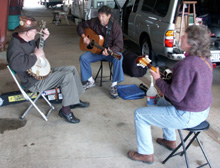
Bluegrass in the Foothills 2004 |
||
| Photos Web Sites More Travel Reports | ||
|
September 16, 2004: Itís bluegrass time again, this time the second annual
ďBluegrassiní in the FoothillsĒ at Plymouth
When I went to load my bike in the trailer this morning, it was gone Ė the cable had been cut. Heading up State 99, I stopped at Target in Modesto and got a new one. Actually I think the thief did me a favor. The gears were messed up on the old bike, and shifting resulted in the chain getting tangled up in the gears. It would probably have cost nearly as much to fix as I paid for the new bike. Following directions provided by the promoter, I left highway 99 a few miles north of Modesto and took Jack Tone Road about 30 miles to Lockeford. This was followed by a highway-hopping route that included State 12, 88, 124, 16 and 49, which is the most direct path to Plymouth. Jack Tone road went through flat agricultural land, with lots of almond orchards the first few miles, then some pumpkins, melons, walnuts, and lots of tomatoes. One tomato field was getting its last picking of the season, as a tractor followed the pickers, plowing the vines under. Several trailers of green tomatoes sat in this field, awaiting transportation to Ė where? The fried green tomato plant? A few
miles past Lockeford, the change to SR 88 brought me into the
beginning of the foothills, first passing through the bluffs along
the Mokelumne
Itís quite warm here (probably about 90) but there is a good breeze from the west, so I spend most of my time outside Ė in the shade with a view of another barn and lots of nice big oak trees. The same promoter put on the festival I attended at Parker AZ in 2003, and he has a reputation for doing a good job. My "official" bluegrass festival plan calls for me to arrive on Wednesday. You can come as early as Monday, but you can nearly always get a good spot on Wednesday. Since the music on stage starts on Friday, Thursday is a day to explore the area. First I explored Plymouth, about a ten-minute job. The population is either 500 (according to the city limit sign) or 900 (according to a lady in city hall). Regardless, it is an incorporated city, one of the smallest in the state. But not the smallest, since nearby Amador City has about 210. In addition to city hall, I visited the local market and the Shell gas station. As a
good bluegrass fan, I felt I would be remiss if I did not drive to
Fiddletown, six miles east of here, so I headed for that old mining
town, which dates from 1849. During the Gold Rush, it reportedly had
the largest Chinese population outside of San Francisco.
It's a very small town, and there did not seem to be anything worth stopping for, so I
continued through town on Fiddletown Road, gaining elevation and getting up into the
ponderosa pine belt. I
had picked up a visitorís guide at the Plymouth
city hall, so I had some guidance as I took Hale Road
to Shake Ridge Road, which led me back down to Highway 49 at Sutter Creek. Another two
miles up the road is Amador
I
skipped the antique stores in Drytown, about half way between Amador
September 19, 2004: Now itís Sunday evening, and as usual I didnít have time to
write once the music started. The festival officially got under way
at We woke up Saturday morning to find it overcast and cool, but with no threat of rain. It was very comfortable all day to wear long pants and a long sleeve shirt. It was clear most of the night, but the morning was again cloudy, and rain started about the same time as the music. At first it was a gentle mist, but soon got to a point where I went to my trailer to dig out my umbrella and poncho. This did not really solve the problem, since a hard driving rain started for a few minutes, getting my chair (and eventually my back side) wet and cold. I again returned to the trailer and listened to some people who were jamming in the barn. Around this time they moved the festival inside an exhibit building, and at noon the music started again. Of course, by this time the rain had stopped and it was looking fairly bright outside, but it soon started raining again, with a fairly strong storm lasting an hour. The weather notwithstanding, the music was good to excellent. Even a group that I did not care for before sounded pretty good, and there were several groups that were great. The best of those I had never heard (or even heard of) was Cedar Hill. It was also my first exposure to a couple of nationally known groups, Honi Deaton and Dream, and the Mark Newton Band. Both were excellent. The best of the best were Karl Shiflett and Big Country, and the US Navy Band Country Current, both of which I had seen before. Another pleasant surprise was Bluegrass Etc., a three piece group. The bass player is Bill Bryson, whom Iíve seen with Laurel Canyon Band and the Grateful Dudes. He also played with the Desert Rose Band with Chris Hillman, and as session player with many big stars. This group was simply amazing for a three piece group. (06/06
update): I also enjoyed John
Murphy & Carolina
Special, Silverado, Rick Jamison and
Copper
When I reviewed the photos from this festival for uploading, I was surprised and amused to find the line-up included a band called Jackstraw. At the September 2005 Kings River festival I won a CD in a drawing. There were two to choose from, neither of which I had ever heard of. The one I picked turned out to be very good. It also turned that I HAD heard of the band - it was Jackstraw. The Plymouth festival, like the one at Paso Robles in March, featured Kids on Stage. This is a project of a man named Frank Sollivan, who encourages us to recognize the very young players who will be in the stage bands of tomorrow. A sign of his success with this project is that fact that his son is now a member of the Navy Band, which means he is at the very top level of bluegrass talent. Iím staying here tonight, just hunkering down in my trailer with the computer, books and the TV set, since itís mighty cold and getting colder outside. September 20, 2004
: After breakfast this morning I hitched up and traveled 23 miles to
Indian
Grinding
Rock
State Park. This park is a few miles off CA 88, north of Pinegrove, which is
just a few miles from The elevation is about 2,400 feet, but with the northern latitude, the vegetation is more like 3,500 feet in our area in the central Sierra. There are pine, cedar, oak and madrone trees here, and it has been bright and sunny all day, but quite cool. In the park is a large section of marbleized limestone with over 1,200 grinding holes made by the Miwok Indians who are native to the area. There is also a very nice Indian museum, and a reconstructed village with bark houses, acorn storage structures, and a large round house. After visiting the village and museum, I continued on north for about two miles to the tiny town of Volcano, population 80, just so I could say I had been there. Actually I was looking for more Christmas shopping locations, but there were no suitable stores, so I went to the much larger town of Pinegrove, population 2,500, where I found a huge antique store with many things I wanted and one that I bought as a gift. When I
got back, it was pretty dark in my campsite (surrounded by woods),
so I took my lawn chair a hundred yards down the hill to a big open
meadow just south of the museum complex. I saw two deer when I first
got down there. By I will head home tomorrow, and get to work deleting spam in my neglected Email box (with no Email access for five full days, I expect to have over 300 messages, at least 250 of which will be deleted unread). Then I can start filling up your Email box with this latest report. By the way, I plan to skip my usual October trip to the Logandale festival, which in the past I have combined with a visit to nearby national parks (in Utah or Arizona). I will probably attend two festivals in Arizona in February and March. --Dick Estel, September 2004 |
||
Photo |
||
 |
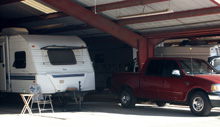 |
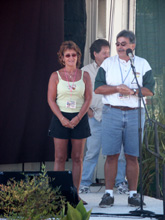 |
| Pickin' in the Barn | Campin' in the Barn | Promoters, Larry & Sondra Baker |
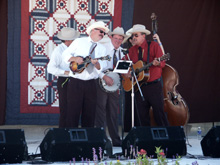 |
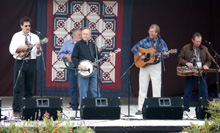 |
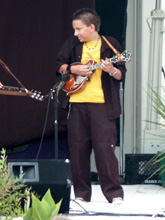 |
| John Murphy & Carolina Special | Silverado | Scott Gates |
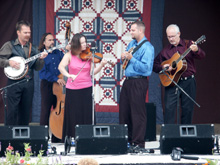 |
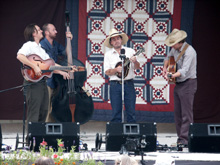 |
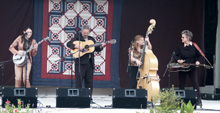 |
| Rick
Jamison & Copper
|
Jackstraw | Lampkins Family |
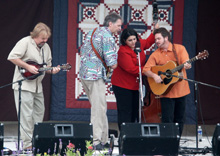 |
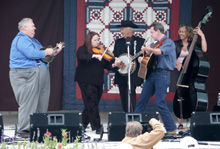 |
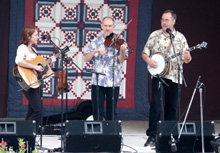 |
| Mark Newton Band | Cedar Hill | Tony Trischka Trio |
 |
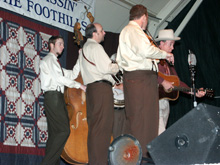 |
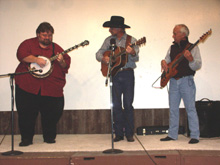 |
| Honi Deaton & Dream | Karl Shiflett & Big Country | Bluegrass Etc. |
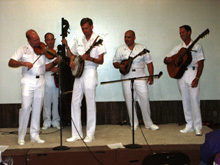 |
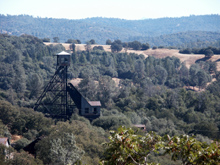 |
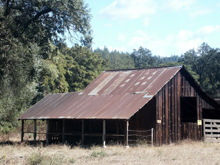 |
| Country Current (Navy Band) | Countryside near Sutter Creek | Barn near Volcano |
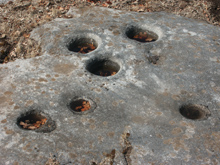 |
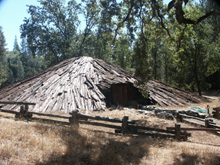 |
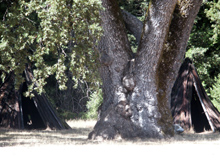 |
| Grinding holes at Indian Grinding Rock State Park |
Miwok Roundhouse | Miwok village and ancient oak |
| Web Sites | ||
| SWBA | L & S Promotions | CBA |
| Country Current (Navy Band) | Karl Shiflett | |
| Tony Trischka | Mark Newton Band | Cedar Hill |
| Honi Deaton | Bluegrass Etc. | |
| Sutter Creek | Plymouth | Amador City |
| Dick's Bluegrass Odyssey | ||

